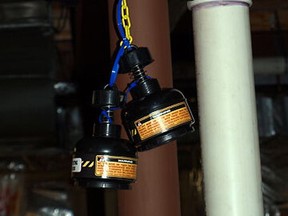A new study suggests the number of Canadian homes with dangerous levels of cancer-causing radon gas has more than doubled since 2012

A new study released this week indicates exposure to invisible and odourless radon gas is increasing across Canada, adding to concern about its effect on human health.
That’s more than double the figure from the last survey in 2012, which estimated 6.9 per cent of homes at or above that mark.
Radon 101
Canada happens to have an abundance of radon, a naturally occurring radioactive gas, because of all the uranium in the country’s vast and diverse geology.
While there are pockets of concentration – British Columbia, the Prairies and Atlantic Canada highest among them – nowhere in the country is radon-free.
Radon released into the air isn’t a cause for concern, but when released inside homes – whether through cracks in the foundation, the groundwater beneath a residence or pipe fittings – it can accumulate to dangerous levels.
Its radioactive state is what makes it so harmful to humans and why it’s become a growing point of concern since the WHO labelled it a Group 1 carcinogen in 1988, which led to further testing to show a direct correlation between radon and cancer of the lung.
The risk is greater for smokers, according to Health Canada. People who light up and are exposed to the 200 Bq/m3 level have a 17 per cent lifetime chance of developing lung cancer compared to just two per cent for non-smokers.
“Two in five cases of lung cancer diagnosed in Canada today are of a non-tobacco origin, and one of the reasons for this is our record high exposure to other potent causes of lung cancer such as radon within the indoor air where we live, work and play,” said Goodarzi, who noted radon gas is the second-leading cause of lung cancer after tobacco use.
More gas could be trapped in new builds
In comparing the recent survey results to the data collected in 2021, the researchers said updated building codes on new builds could have resulted in more “air tightness” that results in more radon being trapped.
The same goes for existing buildings where energy-efficient retrofitting has been done “without increasing the rate of mechanical ventilation.”
“Indeed, over the past decade, federal and provincial incentive programs have increased the uptake of energy-efficient retrofits in older buildings. It is possible that part of the difference in outcomes between the 2024 and 2012 surveys can be attributed to the unintentional impact of certain energy efficiency measures,” the study’s authors noted, while also pointing out that “increased energy efficiency does not, in of itself, necessarily result in high radon.”
Radon be gone
The good news with radon is that it’s relatively easy and inexpensive to test for, both via the DIY method and professionally.
On your own, a small device to place in the lowest level of your home costs anywhere from $30 to $60.
Testing is not immediate – depending on the device used it can take anywhere from four days to up to 12 months to get a precise reading.
If the test comes in over the advised Canadian threshold, professional radon services are needed for mitigation measures that will likely include a soil depressurization system that essentially sucks the radon from beneath the home and vents it into the air.
Depending on the complexity of the work, the project should cost between $2,000 and $4,000.
Our website is the place for the latest breaking news, exclusive scoops, longreads and provocative commentary. Please bookmark nationalpost.com and sign up for our daily newsletter, Posted, here.